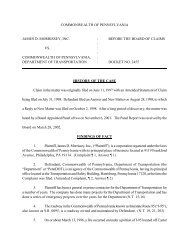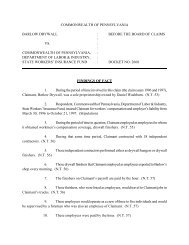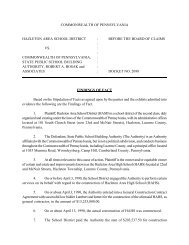3720 - Board of Claims
3720 - Board of Claims
3720 - Board of Claims
Create successful ePaper yourself
Turn your PDF publications into a flip-book with our unique Google optimized e-Paper software.
could properly schedule their crews. (N.T. 38-41, 78-80, 142, 231, 464-465, 501-506, 509; Exs.<br />
P-1M, P-25; <strong>Board</strong> Finding).<br />
57. There is no evidence in the record that Mr. Pilosi or PennDOT ever notified the<br />
Utilities <strong>of</strong> the estimated starting date for this Project prior to the Contract being awarded to<br />
Intercounty in May 2001. (<strong>Board</strong> Finding).<br />
58. In the hearing record, the first notification to the Utilities that the Project was<br />
about to start is a letter dated May 23, 2001 from PennDOT to Intercounty awarding the Contract<br />
that shows copies <strong>of</strong> this letter were sent to the Utilities. Other than this letter, the hearing record<br />
is devoid <strong>of</strong> what other communication, if any, occurred between PennDOT and the Utilities<br />
from January 2000 until the pre-construction meeting on June 4, 2001 regarding the Project.<br />
(Ex. P-7; <strong>Board</strong> Finding).<br />
59. There is no evidence as to whether or not Mr. Pilosi communicated to the Utilities<br />
between January 2000 and May 23, 2001 regarding the Project being funded, an anticipated<br />
bidding or letting date for the Project’s Contract, or any other information regarding the Project<br />
status in advance <strong>of</strong> the May 23, 2001 letter that would have assisted the utility companies to<br />
properly queue the pole relocation work needed for the Project in their work schedules and<br />
promote timely relocation <strong>of</strong> their facilities. (F.O.F. 57-58; <strong>Board</strong> Finding).<br />
60. The lack <strong>of</strong> evidence regarding any communications between<br />
Mr. Pilosi/PennDOT and the Utilities does not establish, as a matter <strong>of</strong> fact, that PennDOT failed<br />
to communicate with the Utilities during this time. (F.O.F. 57-59; <strong>Board</strong> Finding).<br />
61. Mr. Pilosi did state that during the pre-Contract design period, he never informed<br />
the Utilities that this Contract contained a detailed Construction Sequence which PennDOT<br />
developed and which the contractor was required to follow. (N.T. 44-45, 59-60, 464-465; P-2A).<br />
62. Mr. Pilosi did not provide the Construction Sequence to the Utilities until the<br />
June 11, 2001 pre-job meeting. (N.T. 44, 45, 59-60, 446, 464-465, 500-505; Ex. P-2A; <strong>Board</strong><br />
Finding).<br />
63. The Construction Sequence would have told the Utilities where on the Project<br />
they would be expected to start their work (in the south end, in Section One); when to start (after<br />
the contractor completed surveying and staking) and how to plan their work on the Project to<br />
match Intercounty’s work as required by the Contract. (Exs. P-2A, P-2B, P-8 at pp. 30-31, 34-<br />
35).<br />
64. Until the Utilities had the Construction Sequence and the final plans and drawings<br />
for the Project, they were unable to plan and design their work and/or to make time estimates for<br />
their relocation work based on the Construction Sequence or the final plans and drawings that the<br />
contractor had to follow. (N.T. 464-466; F.O.F. 18-63; <strong>Board</strong> Finding).<br />
65. By failing to provide the Utilities with the detailed Construction Sequence prior to<br />
June 11, 2001, PennDOT prevented the Utilities from developing a cogent plan and schedule<br />
9






